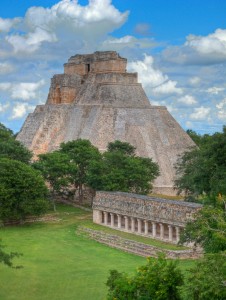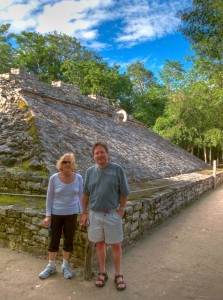In 2009 I took a short vacation in the Yucatan with my brother and sister-in-law. We started and ended our tip at Merida, which has a delightful old city center to explore. [photo gallery]
Uxmal
First on our list was Uxmal, my personal favorite! Located in the gently rolling Puuc Hills, it is one of several significant Late Classic Mayan centers in that area. [photo gallery]
The so-called Pyramid of the Magician dominates the modern entrance to the site (showing its less elaborate back side). The main temple entrance takes the form of a huge mouth, still intimidating even today. The pyramid was actually built in five stages, each covering older parts of the structure. Next to this lies the Nunnery Quadrangle, actually a palace or government building, with its cross-hatched facades and numerous masks.
The site has many other attractions including: a huge rectangular building called the Governor’s Palace; a taller Grand Pyramid that sort of blends into the forest; the Dovecote Temple; a Ball Court; and a double-headed Jaguar Throne. There were also plenty of lizards and birds in residence. Here’s a panorama from the top of the Grand Pyramid (large file).
The site had many intact rooms, all based on the Corbel Arch. The example shown here is particularly beautiful/impressive. Note how the walls gently curve toward the center where the tiny “ceiling” fills the gap.
The example shown here is particularly beautiful/impressive. Note how the walls gently curve toward the center where the tiny “ceiling” fills the gap.
Apparently there is new insight into the ubiquitous masks at Uxmal, Chichen Itza, and other Mayan sites in the Yucatan. Rather than representing the rain god Chaac, scholars propose that they denote hill or mountain beings (witz) and confer sacred status to the structures on which they appear.
Chichen Itza
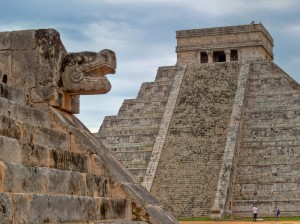 Next on our tour was Chichen Itza, perhaps the most famous Mayan ruin of all. [photo gallery] Most of what we see today is a combination of Terminal Classic Maya and Post-Classic newcomers such as the Toltecs.
Next on our tour was Chichen Itza, perhaps the most famous Mayan ruin of all. [photo gallery] Most of what we see today is a combination of Terminal Classic Maya and Post-Classic newcomers such as the Toltecs.
The site is dominated by the iconic El Castillo Pyramid, which was dedicated to the feathered serpent god Kukulkan. The restored stairway is flanked by gigantic stone serpents. Additional buried sturctures have recently been discovered at its base. The numerological and astronomical aspects of this temple are many, but my favorite is how a sunlit snake appears every equinox. If you clap your hands you will hear an eerie bird call (which our guide claimed was a Quetzal).
 The Temple of the Warriors is a fantastic edifice, with many carved columns. Each carved side depicts a warrior in full regalia with a huge headdress standing on a mystical serpent. Unfortunately I was limited to walking around it so I could not get close to the better parts. <frown> The temple is contiguous with a huge array of circular columns that once supported a roof. One platform is ringed by carvings of eagles and jaguars.
The Temple of the Warriors is a fantastic edifice, with many carved columns. Each carved side depicts a warrior in full regalia with a huge headdress standing on a mystical serpent. Unfortunately I was limited to walking around it so I could not get close to the better parts. <frown> The temple is contiguous with a huge array of circular columns that once supported a roof. One platform is ringed by carvings of eagles and jaguars.
 Mirroring this theme across a broad grassy area in front of the Castillo is the small but elegant Platform of Eagles and Jaguars. It has well-preserved reliefs and snakehead ornamentation on all sides.
Mirroring this theme across a broad grassy area in front of the Castillo is the small but elegant Platform of Eagles and Jaguars. It has well-preserved reliefs and snakehead ornamentation on all sides.
 Behind the temple is a series of low platforms ending in the Tzompantli or Skull Rack. Apparently the skulls of captives and sacrificial victims were displayed here stacked on wooden stakes.
Behind the temple is a series of low platforms ending in the Tzompantli or Skull Rack. Apparently the skulls of captives and sacrificial victims were displayed here stacked on wooden stakes.
 The Platform of Venus sported carvings of men emerging from the mouths of a feathered serpent. The friezes above each of these had whimsical images of tadpoles. There were so many things to see in this area I lost track! Unfortunately it remained cloudy all morning so photography was difficult.
The Platform of Venus sported carvings of men emerging from the mouths of a feathered serpent. The friezes above each of these had whimsical images of tadpoles. There were so many things to see in this area I lost track! Unfortunately it remained cloudy all morning so photography was difficult.
 A wide raised road or Sacbe leads from this area 1000ft to the Sacred Cenote. The road passes through a perimeter wall that once guarded the temple area. This area was lined with local vendors standing shoulder to shoulder in hopes of making a sale. There’s not much to see now, but in its day the Cenote was used to sacrifice to the rain god Chaac.
A wide raised road or Sacbe leads from this area 1000ft to the Sacred Cenote. The road passes through a perimeter wall that once guarded the temple area. This area was lined with local vendors standing shoulder to shoulder in hopes of making a sale. There’s not much to see now, but in its day the Cenote was used to sacrifice to the rain god Chaac.
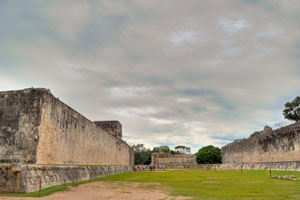 The Grand Ball Court is truly enormous, and one wonders whether it was a ritual center rather than a venue for actual competition (the rings are thirty feet high!). On the sidelines are carvings of the players, one of which can be seen holding a knife and a severed head! The small Temple of the Bearded Man is in the north end zone. The Upper Temple of the Jaguar overlooks the southern end.
The Grand Ball Court is truly enormous, and one wonders whether it was a ritual center rather than a venue for actual competition (the rings are thirty feet high!). On the sidelines are carvings of the players, one of which can be seen holding a knife and a severed head! The small Temple of the Bearded Man is in the north end zone. The Upper Temple of the Jaguar overlooks the southern end.
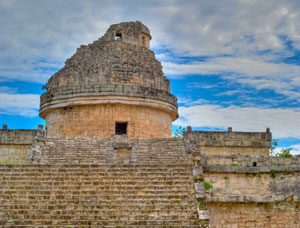 I’ll conclude with a description of The Observatory and its companions. (It is also known as the Caracol or snail because of its spiral stairs.) This was a functioning astronomical observatory with small apertures aligned to the movements of the Sun, Moon and the planet Venus. (It was very frustrating not to have better access!) It sits on a platform with huge overhanging walls. We also had a great view at night from the hotel bar. (I’m not kidding!)
I’ll conclude with a description of The Observatory and its companions. (It is also known as the Caracol or snail because of its spiral stairs.) This was a functioning astronomical observatory with small apertures aligned to the movements of the Sun, Moon and the planet Venus. (It was very frustrating not to have better access!) It sits on a platform with huge overhanging walls. We also had a great view at night from the hotel bar. (I’m not kidding!)
Across a small lawn were two small Puuc style buildings with elaborate carvings. One known as The Church had a crown of masks. The other had a seated figure over the door. Beside them were the remains of a ritual bath with walk-in tub!
Coba
On our drive to the coast we stopped for a few hours to see the ruins at Coba. The site sits between two lakes and is divided up into groupings several kilometers apart. These are much more rustic with less restoration. [photo gallery] One exception was the Ball Court which was very small an intimate compared with the others we’d seen. One tall pyramid had vultures sunning themselves at the top.
 As we walked along the path through the jungle we came upon this cute little round pyramid. There were several stelae covered by thatched roofs, but the inscriptions were all but gone. <frown>
As we walked along the path through the jungle we came upon this cute little round pyramid. There were several stelae covered by thatched roofs, but the inscriptions were all but gone. <frown>
 We finally reached the Nohoch Mul Pyramid and started to climb. The view from the top was of spectacular! There was a small figure in the center of the temple that I believe is the same diving god found at Tulum.
We finally reached the Nohoch Mul Pyramid and started to climb. The view from the top was of spectacular! There was a small figure in the center of the temple that I believe is the same diving god found at Tulum.
Tulum
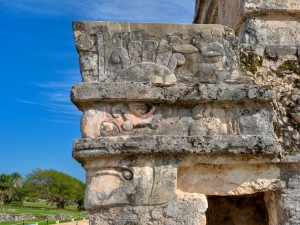 Our final stop was Tulum on the east coast. [photo gallery] While the buildings may be less elaborate, the setting is certainly spectacular. A thick wall surrounds the site on three sides with the ocean on the fourth. The site has its own small cenote as a source of fresh water. There is a guard house of sorts just above that looks out on the turquoise Caribbean.
Our final stop was Tulum on the east coast. [photo gallery] While the buildings may be less elaborate, the setting is certainly spectacular. A thick wall surrounds the site on three sides with the ocean on the fourth. The site has its own small cenote as a source of fresh water. There is a guard house of sorts just above that looks out on the turquoise Caribbean.
 Other small buildings spread along the cliffside create dramatic views. It is ironic that the largest temple structure faces inland and is therefore unattractive when viewed from the shoreline. It is completely closed off to the public. <frown> Here’s a panorama (large file).
Other small buildings spread along the cliffside create dramatic views. It is ironic that the largest temple structure faces inland and is therefore unattractive when viewed from the shoreline. It is completely closed off to the public. <frown> Here’s a panorama (large file).

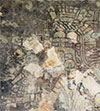 By far the most interesting building is the small Temple of the Frescos. It has huge humanoid masks (see above) at each corner and badly eroded carvings of the diving god above the doorways. Inside are still visible paintings of various gods. (You can just make out the goddess Ixchel carrying the infant Chaac toward the center of the photograph.)
By far the most interesting building is the small Temple of the Frescos. It has huge humanoid masks (see above) at each corner and badly eroded carvings of the diving god above the doorways. Inside are still visible paintings of various gods. (You can just make out the goddess Ixchel carrying the infant Chaac toward the center of the photograph.)

